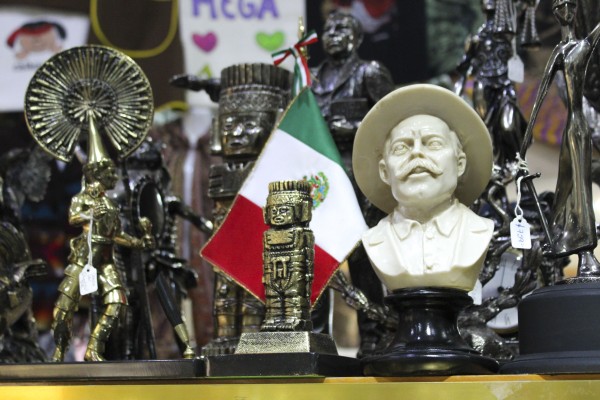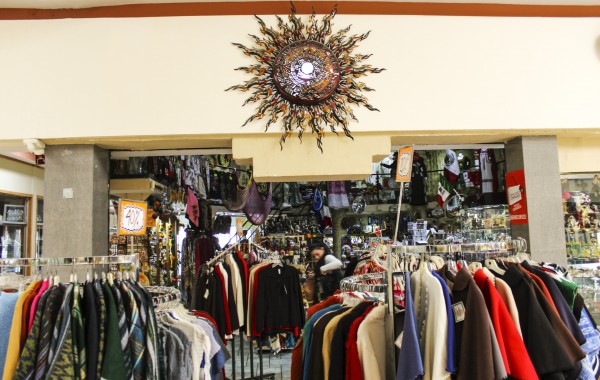
JUAREZ, MEXICO. – Every morning Lupita Hernandez swings open the doors of her arts and crafts store here to a bright and prosperous new day, just like she and her mother have done for more than 40 years.
However the legacy of this family institution was put at risk during the years that Juarez was held hostage by organized crime and drug cartels. The threat of violence hit close to home for Lupita when extortionists called her store, El Calendario Azteca, which had been well-established here in the Rio Grande Mall, one of the oldest shopping centers in the city.
The threatening phone call came one evening right out of the Yellow Pages.
“We got a call from ‘la linea.’ Supposedly they found our information on the phone book,” Hernandez said. ” I answered the phone and they asked if we were already paying our ‘cuota.’ About three days later two suspicious men walked into the store and asked to talk with the owners, I told them I was just an employee and that the owners were not at the store. They left after a while.”
Because of the extortion call and the visit, Hernandez changed all the phone numbers, changed her routines and started being really careful with whom she shared any information. After they alerted the authorities and the official complaint was made, they were never again approached by the gangsters.
Juarez became known during that time as “The Murder Capital of the World.” Murders and other violent crimes reached a bloody peak around 2010 when according to numbers from the Observatorio Ciudadano of the state of Chihuahua there were approximately 110 homicides and seven kidnappings for every 100,000 citizens in this city of 2.5 million people.
“We used to see people crossing from El Paso, especially on weekends, but all of the sudden that stopped,” Hernandez said.
Thousands fled the city and many found shelter just across the border in El Paso, Texas. However the vast majority was unable to leave and were forced to weather the storm. Many of them were business owners like Hernandez, who could not bear the thought of leaving everything their families fought so hard to build.
El Calendario Azteca is a rare sight even in a big city like Juarez. Walking into the store customers are immediately transported to a different place. They exit a shopping mall and enter a colorful and radiant plaza that looks like the heart and soul of a Mexican pueblo. Beautiful and bright mariachi, charro and chinas poblanas outfits as well as multicolored sarapes hang from the walls. All of the sudden the store is converted into the heart of a mercado worthy of the most popular tourist cities in Mexico.
“This shop comes originally from Mexico City, my mother brought it to Juarez and we were one of the first shops to open at this mall,” Hernandez said.
Because of its proximity to international bridges, Rio Grande Mall was at one point a common stop for many El Pasoans to shop for fresh produce and groceries.
Hernandez said that during the most violent years such as 2009 and 2010 shoppers started to disappear from the mall. Stores had to close early to avoid the darkness that threatened them outside.

Pancho Villa and Aztec Images are among the best sellers of “Calendario Azteca” Photo credit: Genaro Cruz
“It was difficult, very difficult but even more important than tourists at one point what really helped was that we were lucky enough to have a local core-clientele that kept coming back. Even when other stores were struggling to earn their workers’ salaries and “aguinaldos” (holiday bonus) we always managed to make ends meet,” she said.
Juarez had become a playground for “sicarios” kidnappers and drug dealers. The city slowly started to recover, month after month while the number of murders decreased the confidence and braveness of “juarenses” increased.
El Calendario Azteca has witnessed Juarez’s resurgence after years as the most violent city in the world. Hernandez and her employees have seen first-hand the worst of times in the city and now its slow but sure recovery.
The crime statistics for 2014, while far from perfect, where very encouraging. Some 30 homicides for every 100,000 citizens and 0.2 kidnappings. Murders saw a decrease of 13 per cent compared to 2013.
Enrique Serrano, mayor of Juarez, attributed the reduction of violence to the hard work of prosecuting criminals in the state of Chihuahua. “We juarenses feel very proud of the work of the prosecution. It needed a major transformation, which has happened, bringing great results to the city.”
The mayor also said that those years of violence taught the community and authorities a big lesson. “It is a well-known fact that we had some difficult times a few years ago when this city became a battlefield. The most important lesson this crisis left us is that problems need to be solved from the root and this can only be accomplished through prevention and the correct upbringing of our kids and youth.”
Hernandez says that the change in the city is really noticeable, as people feel safe again and even when every now and then there are still major violent crimes in broad daylight there is no going back to the old days of constant crime. Shoppers have more confidence and they are starting to feel safe again, The citizens of Juarez are now willing to fight and the city is back, she said.
“The mall is at a full capacity on weekends and even folks from El Paso are coming back. We noticed things started to change last year around September for the festivities of the Mexican Independence — more people started showing up to the store, including people from other cities,” she said.
